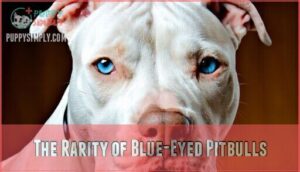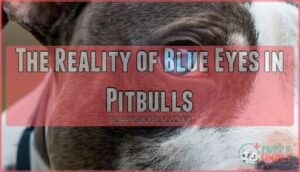This site is supported by our readers. We may earn a commission, at no cost to you, if you purchase through links.
 When you stumble upon a blue-eyed Pitbull, you can’t help but stare—they’re rare for a reason.
When you stumble upon a blue-eyed Pitbull, you can’t help but stare—they’re rare for a reason.
The controversy around the blue eyed pitbull sparks when breeders chase looks over health, mixing in genes like merle, which Pitbulls don’t naturally have.
While those eyes might turn heads at the dog park, there’s often trouble brewing beneath the surface.
Issues like vision problems, deafness, or other health quirks can tag along for the ride. You want the facts, not fairy tales—so let’s pull back the curtain and see what really makes that gaze so unusual and what risks come with the sparkle.
Table Of Contents
- Key Takeaways
- Can Pitbulls Have Blue Eyes?
- The Rarity of Blue-Eyed Pitbulls
- Vision Issues in Blue-Eyed Dogs
- Dog Breeds That Can Have Blue Eyes
- Understanding Pitbulls as a Breed
- Factors Influencing Blue Eye Color in Pitbulls
- The Disappearance of Blue Eyes in Pitbull Puppies
- Health Concerns in Blue-Eyed Pitbulls
- The Appearance of Blue-Eyed Pitbulls
- The Reality of Blue Eyes in Pitbulls
- Frequently Asked Questions (FAQs)
- What do blue eyes mean on a pit bull?
- Why are pit bulls so controversial?
- How much does a blue eyed pitbull puppy cost?
- Do blue pitbulls have health problems?
- What is the temperament of blue-eyed Pitbulls?
- Do blue eyes affect a Pitbull’s training ability?
- How do blue-eyed Pitbulls interact with children?
- What are common myths about blue-eyed Pitbulls?
- Conclusion
Key Takeaways
- Blue-eyed bulls are rare, and chasing that look through breeding can risk your dog’s health—deafness and vision problems often tag along.
- Breeders who focus on appearance over health may use the merle gene, which isn’t natural for Pitbulls and brings extra health risks.
- Always ask breeders about genetic testing and choose those who prioritize transparency and responsible breeding practices.
- Don’t let striking eye color sway you—put your future pup’s well-being above looks and questionable trends.
Can Pitbulls Have Blue Eyes?
Almost anyone loves the striking look of a blue eyed pitbull, but those baby blues aren’t as simple as they seem.
The ALX4 gene role and melanin impact both play a part, along with the notorious Merle gene effects. Blue eyes can mean unique beauty—or hint at health risks and pitbull health issues tied to pitbull genetics.
Responsible breeding and dog breeding ethics matter, so always ask breeders about genetic testing. A little homework means you’re getting cuteness without unwanted surprises down the line.
The Rarity of Blue-Eyed Pitbulls
You might spot plenty of blue-eyed puppies, but a Pitbull that keeps those striking eyes as an adult is a rare find.
Think of it like hanging onto a baby’s blue eyes—not something you see every day, and often just a phase.
Breeding Practices for Appearance
Blue eyes in Pitbulls might catch your eye, but breeding for just color preference can stir up a storm of ethical concerns. When folks chase rare aesthetic reasons instead of health prioritization, you get more than pretty puppies—you risk vision and hearing issues that no one wants in a family dog.
Chasing rare blue eyes in Pitbulls can lead to unexpected health risks—always prioritize well-being over trendy colors.
Responsible breeders understand dog breeding ethics isn’t about trends or hefty price tags, it’s about doing right by the dog and the breed. If you’re thinking about a blue-eyed Pitbull, keep these in mind:
- Always ask about genetic testing for both parents.
- Look for breeders who follow breed standards and transparent breeding practices.
- Be wary if rarity seems to eclipse health considerations in puppy ads.
- Trust breeders who champion ethical dog breeding and honest conversations about risks.
- Additionally, understanding the role of the merle gene effect is vital in making informed decisions about blue-eyed Pitbulls.
Smart choices today mean fewer headaches (and vet trips) tomorrow, which is why prioritizing health prioritization and responsible breeders is crucial for the well-being of your pet, emphasizing the importance of transparent breeding practices and being aware of potential vision and hearing issues.
The Impact of The Merle Gene
If you’ve seen a blue eyed pitbull in person, chances are the Merle Gene is at play.
Its Merle Gene Expression creates striking Merle color variations, but also brings Merle Health Risks that can’t be ignored.
Cryptic Merle surprises even seasoned breeders, making Merle Breeding Ethics essential.
Merle Pitbulls aren’t breed standard and are considered a fault.
Think twice before breeding for looks—genetic factors always matter.
Albinism and White Fur Patches
After looking at the role of the Merle gene, it’s worth clearing up the confusion around albinism and white fur color in pitbulls.
Not all patches of white mean your pup is albino. True albinism is rare and linked to melanin deficiency, leading to pink skin, pale noses, and very light blue or see-through eyes.
Most often, white fur patches come from pigment dilution or simple genetic quirks—not a full lack of melanin. These spots look charming but don’t usually carry health implications.
Albino pitbulls, however, need extra protection from sun exposure as they’re at higher risk for skin cancer and poor vision. Genetic testing can clear up what’s really going on.
Picking a dog for its looks alone? Ethical breeding should always put health and well-being first, not just rare colors.
Vision Issues in Blue-Eyed Dogs
If you’re eyeing a blue eyed pitbull, remember those pale peepers can come with their own baggage.
Genes tied to the Merle gene sometimes bring along vision defects and even Merle-related Blindness. Cataract Risks and Distichiasis Impact also lurk in the genetic shadows, making regular vet visits a smart call.
Watch out for signs of trouble:
- Cloudy or bluish eyes
- Squinting in sunlight
- Bumping into furniture unexpectedly
- Oddly shaped pupils
Stay on top of canine genetic disorders so your buddy’s vision issues don’t take you by surprise.
Dog Breeds That Can Have Blue Eyes
Ever admired the wild spark in a Husky’s gaze or the piercing stare of an Australian Shepherd? You’re not alone—blue eyes in dogs pop up in more than just the blue eyed pitbull, thanks to Dalmatian genetics, the Merle gene, and other quirks.
Border Collie hues, Weimaraner traits, and Siberian Huskies all flaunt these icy peepers. Before choosing your next companion based on looks, here’s how some pups stack up:
| Breed | Usual Eye Color | Genetic Factor |
|---|---|---|
| Siberian Husky | Blue/Brown/Mixed | ALX4 mutation |
| Australian Shepherd | Blue/Brown/Ambers | Merle gene |
| Dalmatian | Brown/Blue | Melanin level |
| Weimaraner | Light amber/Blue | Low melanin |
| Border Collie | Various—including blue | Merle gene |
Understanding Pitbulls as a Breed
Few breeds spark as much chat—and as many misconceptions—as the Pitbull.
To really understand this dog, remember these essentials:
- Their history ranges from farm helpers to loyal companions.
- Temperament traits: loyal, smart, and often misunderstood.
- Breed standards focus on health before trends.
Don’t let dog breeding controversy or Blueeyed Pitbulls cloud your view.
Responsible breeders follow strict Pitbull breed standards, ensuring each pup’s well-being.
Regarding Pitbull breed variations, ethical considerations always beat quick fixes or shortcuts.
Truth is, owning one is both a joy and a duty!
Factors Influencing Blue Eye Color in Pitbulls
You might notice a blue-eyed Pitbull and wonder what’s happening behind those striking eyes—there’s actually science at work.
Genes like ALX4 and the amount of melanin in the iris play major roles, making your pitbull’s gaze more than just a head-turner at the dog park.
The ALX4 Gene
Every so often, a scientific discovery like the ALX4 gene mutation grabs attention for its Blue Eye Link in dogs.
Nestled on Canine Chromosome 18, this genetic change can tip the scales for eye color genetics, sometimes popping up even in a blue eyed pitbull.
The ALX4 gene influences melanin production in the iris, setting the stage for blue hues.
If you’re considering a pup, quality genetic testing can help spot potential vision issues tied to these genetic factors, ensuring only healthy companions join your family.
Melanin Levels
Regarding eye color in Pitbulls, melanin levels steal the show.
Melanin production shapes iris pigmentation; less of it means those striking blue eyes, especially in puppies.
That tempting blue may fade with age or shift if genetic factors like the merle gene come into play.
If you’ve ever wondered why some blue eyed pitbull pups grow up with brown eyes, it’s not magic—it’s melanin at work.
Remember, light sensitivity and health risks can also follow unique eye color patterns.
The Disappearance of Blue Eyes in Pitbull Puppies
Regarding blue eyed pitbull puppies, you might notice a Puppy Eye Change—the vivid blue gradually fades as Melanin Production Increases.
That adorable eye color transformation often gives way to darker shades. Why? Pigmentation Development kicks in, guided by genetic predisposition and breed standards.
Don’t count on those dreamy puppy eyes forever. Imagine this journey:
- Born with brilliant blue eyes
- Melanin development kicks in
- Gradual shift to deeper tones
- Adult eye color settles
- Only a lucky few keep blue
The process of Melanin Production and Pigmentation Development results in a change from the initial eye color, leading to a more mature tone.
Health Concerns in Blue-Eyed Pitbulls
You might find blue eyes charming, but they can signal some hidden health concerns in Pitbulls.
It’s important to know that issues like deafness or blindness sometimes come with those striking baby blues, so keeping a close watch on your pup is a smart move to address potential health issues related to deafness.
Deafness
If your blue eyed pitbull starts ignoring the doorbell, it mightn’t be stubbornness—it could be deafness linked to genetic predisposition, especially if the Merle gene is involved.
Early detection is key, so ask your vet about BAER testing. Choosing breeders who screen for genetic factors helps with deafness prevention.
Sure, assistive devices and visual cues make life easier if hearing fades, but focusing on health risks over fancy colors saves heartache—and money.
To address potential hearing issues, consider using a dog hearing test for early detection.
| Real Talk | Quick Tip |
|---|---|
| Deafness is common | BAER test for early check |
| Merle gene = risk | Choose ethical breeders |
Blindness
Just when you thought deafness was the only curveball, vision issues step into the spotlight.
Blindness in blue eyed pitbulls, while rare, is often tied to double merle genetics and isn’t something you want to gamble with.
Watching for signs like bumping into walls or cloudy eyes can help catch problems early, but keep in mind:
- Merle gene links to vision defects
- Double merle pups face higher health risks
- Cataracts and other eye conditions show up
- Progressive blindness can sneak in quietly
- Genetic factors play a key role
Similar to French Bulldogs, melanin levels impact eye color, which is also influenced by genetic factors and can lead to vision defects or progressive blindness.
The Appearance of Blue-Eyed Pitbulls
If you’ve ever locked eyes with a blue-eyed Pitbull, you’ll notice their gaze is mesmerizing—like staring into a chilly lake at dawn.
That unique shade often springs from low melanin production, highlighting how Eye Color Genetics and Melanin levels shape canine beauty.
While Puppy Eye Change can bring surprises, adult eye color speaks volumes about genetic factors at play.
Breed standards don’t always favor blue eyes in dogs, and pitbull eye problems can sometimes be linked to emphasizing appearance over health.
Always look past the color; focus on well-being. This can be influenced by the Merle gene (ALX4) which impacts pigmentation.
The Reality of Blue Eyes in Pitbulls
Eye color genetics in Pitbulls is a winding road, full of surprises and a few potholes. If you’re enchanted by blue eyes in dogs, remember there’s more than meets the eye.
Melanin production impact, genetic mutations, and breed standard issues play a role. Keep an eye out for these:
- Merle gene ups chances for deafness and pitbull eye problems
- Lack of melanin affects puppy eye development and vision
- Double Merle gene means bigger health risks
- Albinism adds sun sensitivity
- Ethical breeding concerns always matter
The key factors to consider are the genetic implications and the potential health risks associated with certain traits, such as the Merle gene.
Frequently Asked Questions (FAQs)
What do blue eyes mean on a pit bull?
Like rare sapphires in a field of pebbles, those stunning blue eyes often mean your pit bull carries unique genes, which may signal rare beauty—but sometimes, extra health risks.
Keep an eye out, just in case!
Why are pit bulls so controversial?
Pit bulls draw controversy because of their unpredictable history, strong build, and negative headlines.
People worry about safety, stereotypes, and breed bans.
It’s a classic case of judging a book by its cover—sometimes fairly, often unfairly.
How much does a blue eyed pitbull puppy cost?
You’ll often find blue-eyed Pitbull puppies priced anywhere from $800 to $3,000, depending on the breeder and pedigree.
Don’t let the dazzling eyes fool you—health checks and ethical breeding are worth their weight in gold.
Do blue pitbulls have health problems?
Genetic quirks, inherited risks, hidden surprises—blue Pitbulls can face health issues like vision, hearing troubles, or skin problems.
You’ll want to ask breeders about genetic testing and health checks before bringing one home.
Safety first, right?
What is the temperament of blue-eyed Pitbulls?
You’ll find that blue-eyed Pitbulls act just like their brown-eyed buddies—loyal, affectionate, and energetic.
Don’t expect their eye color to change their attitude; they crave attention, love a belly rub, and enjoy being part of your pack.
Do blue eyes affect a Pitbull’s training ability?
Ever wonder if your dog’s eye color holds the key to genius-level trick training?
Blue eyes don’t affect a Pitbull’s ability to learn.
Focus on positive reinforcement—your dog’s talent comes from you, not their looks.
How do blue-eyed Pitbulls interact with children?
Blue-eyed Pitbulls interact with kids just like any other well-socialized pitbull—full of playful energy and loyalty.
With proper training and supervision, you’ll find their bond strong, their patience steady, and their companionship rewarding.
What are common myths about blue-eyed Pitbulls?
A lot of folks think blue-eyed Pitbulls are more aggressive or always unhealthy, but that’s barking up the wrong tree.
Eye color doesn’t dictate temperament, and while some have health quirks, not every blue-eyed pup does.
Conclusion
Like a hidden iceberg, the controversy around the blue eyed Pitbull lurks beneath their striking gaze.
You’ve now seen that, while blue eyes might look cool, they can signal underlying genetic quirks, health risks, or questionable breeding practices.
If you’re smitten by those baby blues, just remember: it’s smart to ask questions and dig deeper before bringing a blue-eyed Pitbull home.
Let facts, not fairy tales, guide your choices—your future best friend will thank you, and always prioritize their well-being over questionable breeding practices.













